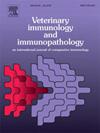Cathelicidins in farm animals: Structural diversity, mechanisms of action, and therapeutic potential in the face of antimicrobial resistance
IF 1.4
3区 农林科学
Q4 IMMUNOLOGY
引用次数: 0
Abstract
Cathelicidins are a diverse family of antimicrobial peptides found across many vertebrate species, playing a pivotal role in the innate immune system. These peptides exhibit a variety of structural motifs, including α-helices, β-hairpins, and random coils, contributing to their broad-spectrum antimicrobial activity. The structural diversity of cathelicidins allows them to interact with a wide range of microbial targets, thereby enhancing their antimicrobial efficacy. Distinct species produce specific cathelicidins, each adapted to meet their unique immune requirements. Cathelicidins primarily function by disrupting microbial membranes, leading to cell lysis. Beyond their direct antimicrobial action, they possess immunomodulatory properties that bolster host defense mechanisms. These properties include promoting chemotaxis, enhancing phagocytosis, and inducing cytokine production, thereby modulating the host immune response. The therapeutic potential of cathelicidins is significant, especially in light of the growing challenge of antimicrobial resistance (AMR). As conventional antibiotics lose efficacy, cathelicidins emerge as promising alternatives due to their unique mechanisms of action and reduced likelihood of inducing resistance. Recent research underscores their potential in treating infections, inflammatory diseases, and even cancer. Advances in synthetic biology offer promising prospects for effective cathelicidin-based therapies in the future. This review summarizes the diversity, modes of action, and clinical prospects of cathelicidins specific to farm animals.
农场动物中的抗菌肽:结构多样性,作用机制,以及面对抗菌素耐药性的治疗潜力。
抗菌肽是多种多样的抗菌肽家族,存在于许多脊椎动物物种中,在先天免疫系统中起着关键作用。这些肽具有多种结构基序,包括α-螺旋,β-发夹和随机线圈,有助于其广谱抗菌活性。抗菌肽的结构多样性使其能够与广泛的微生物靶点相互作用,从而增强其抗菌功效。不同的物种产生特定的抗菌素,每一种都适应其独特的免疫需求。抗菌肽的主要作用是破坏微生物膜,导致细胞裂解。除了它们的直接抗菌作用外,它们还具有增强宿主防御机制的免疫调节特性。这些特性包括促进趋化性,增强吞噬作用,诱导细胞因子的产生,从而调节宿主免疫反应。抗菌肽的治疗潜力是显著的,特别是在抗菌素耐药性(AMR)日益增长的挑战。随着传统抗生素失去疗效,抗菌肽因其独特的作用机制和降低诱导耐药性的可能性而成为有希望的替代品。最近的研究强调了它们在治疗感染、炎症性疾病甚至癌症方面的潜力。合成生物学的进步为未来有效的基于抗菌肽的治疗提供了广阔的前景。本文综述了家畜专用抗菌肽的种类、作用方式及临床应用前景。
本文章由计算机程序翻译,如有差异,请以英文原文为准。
求助全文
约1分钟内获得全文
求助全文
来源期刊
CiteScore
3.40
自引率
5.60%
发文量
79
审稿时长
70 days
期刊介绍:
The journal reports basic, comparative and clinical immunology as they pertain to the animal species designated here: livestock, poultry, and fish species that are major food animals and companion animals such as cats, dogs, horses and camels, and wildlife species that act as reservoirs for food, companion or human infectious diseases, or as models for human disease.
Rodent models of infectious diseases that are of importance in the animal species indicated above,when the disease requires a level of containment that is not readily available for larger animal experimentation (ABSL3), will be considered. Papers on rabbits, lizards, guinea pigs, badgers, armadillos, elephants, antelope, and buffalo will be reviewed if the research advances our fundamental understanding of immunology, or if they act as a reservoir of infectious disease for the primary animal species designated above, or for humans. Manuscripts employing other species will be reviewed if justified as fitting into the categories above.
The following topics are appropriate: biology of cells and mechanisms of the immune system, immunochemistry, immunodeficiencies, immunodiagnosis, immunogenetics, immunopathology, immunology of infectious disease and tumors, immunoprophylaxis including vaccine development and delivery, immunological aspects of pregnancy including passive immunity, autoimmuity, neuroimmunology, and transplanatation immunology. Manuscripts that describe new genes and development of tools such as monoclonal antibodies are also of interest when part of a larger biological study. Studies employing extracts or constituents (plant extracts, feed additives or microbiome) must be sufficiently defined to be reproduced in other laboratories and also provide evidence for possible mechanisms and not simply show an effect on the immune system.

 求助内容:
求助内容: 应助结果提醒方式:
应助结果提醒方式:


